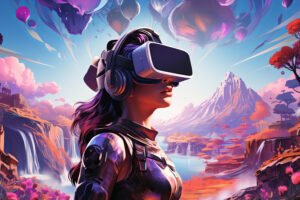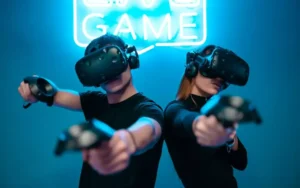Virtual Reality (VR) has become a rapidly growing trend in the gaming industry, allowing players to immerse themselves in virtual worlds and experience gameplay like never before.
However, creating a VR game is a complex task requiring considerable time and resources. One of the key questions that game developers and stakeholders often ask is, “How long does VR game development take?”
The answer to this question depends on various factors, including the game’s complexity, team size and expertise, development tools, and market trends. This article will explore the factors affecting VR game development timelines and provide some tips and best practices for optimizing the development process.
Factors Affecting VR Game Development Duration
Here are some of the factors that can affect the duration of VR game development:
1. Game Genre And Complexity
The genre and complexity of the game can significantly impact the development timeline. For instance, a simple puzzle game may take less time to develop than a complex first-person shooter game with intricate level designs and artificial intelligence (AI) systems.
Developers need to consider the amount of content, gameplay mechanics, and technical requirements when estimating the project’s duration.
2. Hardware And Software Requirements
VR game development requires specialized hardware and software tools, such as VR headsets, motion controllers, and game engines.
The availability and compatibility of these tools can affect the development timeline. Developers must ensure that the game runs smoothly on different VR platforms and hardware configurations.
3. Team Size And Expertise
The size and expertise of the development team can also impact the duration of VR game development. A larger team may be able to complete tasks more quickly, but it can also increase communication overhead and coordination efforts.
Moreover, the expertise and skill set of the team members can influence the quality and speed of development.
4. Design And Prototyping Phase
The design and prototyping phase is crucial for VR game development, as it sets the foundation for the entire project. This phase involves conceptualising the game mechanics, level designs, characters, and assets and testing them in a virtual environment.
Depending on the game’s complexity, this phase can take weeks to months.
5. Testing And Quality Assurance Phase.
The testing and quality assurance phase ensures the game is bug-free and meets the desired performance and user experience standards. This phase can involve alpha, beta, and release candidate testing, user testing and feedback incorporation.
The duration of this phase can depend on the number of bugs and issues discovered and the amount of time required to fix them.
6. Marketing And Distribution Considerations
Once the game is ready for launch, developers need to plan for its marketing and distribution. This phase can involve creating promotional materials, building a community, and negotiating distribution deals with various platforms.
The duration of this phase can depend on the game’s visibility and popularity, as well as the distribution partners’ requirements.
In conclusion, several factors can impact the duration of VR game development. By understanding these factors, developers can plan and budget their projects more effectively and optimize their development processes to deliver high-quality VR games.

Phases Of VR Game Development And Their Duration
VR game development can be divided into several phases with tasks and duration. Here are some of the common phases of VR game development and their typical duration’s:
1. Concept And Design Phase
This phase involves brainstorming and conceptualizing the game idea, defining its scope, and creating a game design document (GDD) that outlines the game’s mechanics, characters, levels, and other features. This phase can last from a few weeks to several months, depending on the game’s complexity and the Team’s experience.
2. Prototyping Phase
In this phase, developers create a rough version of the game’s core mechanics, often called a vertical slice. This prototype helps the Team test the game mechanics, identify technical or design issues, and iterate on the design. The duration of this phase can vary from a few weeks to a few months, depending on the game’s complexity.
3. Pre-Production Phase
This phase involves creating detailed art assets, level designs, and gameplay mechanics based on the GDD and prototype. The Team also prepares the game’s technical architecture and creates development tools and pipelines. Depending on the game’s scope and complexity, the pre-production phase can take a few months to a year.
4. Production Phase
The production phase involves implementing the game’s mechanics, creating the game’s assets, and building the levels. The Team also integrates AI systems, physics engines, and other technical features. The duration of this phase can vary widely depending on the game’s size and complexity, ranging from a few months to several years.
5. Testing And Quality Assurance Phase
This phase involves testing the game for bugs, issues, and usability problems and ensuring it meets the desired performance and user experience standards.
The Team may conduct alpha, beta, and release candidate testing and incorporate feedback from user testing. The duration of this phase can vary depending on the number of issues found and the time required to fix them.
6. Marketing And Distribution Phase
Once the game is released, the Team must plan and execute its marketing and distribution strategy. This phase can involve creating promotional materials, building a community, and negotiating distribution deals with various platforms. The duration of this phase can depend on the game’s visibility and popularity and the distribution partners’ requirements.
In conclusion, the duration of VR game development can vary widely depending on the game’s scope, complexity, team size and expertise.By breaking down the development process into these phases, developers can plan and budget their projects more effectively and ensure they deliver high-quality VR games on time.
Case Studies Of Popular VR Games And Their Timelines
Virtual Reality (VR) gaming has become increasingly popular in recent years, with more and more games being developed for VR platforms. To better understand the timelines for developing popular VR games, we can look at several case studies. One popular VR game is Job Simulator, developed by Owlchemy Labs. The development timeline for the game was around 14 months. The Team started by experimenting with VR technology and creating a prototype for the game mechanics.
They then spent several months iterating on the game’s design, implementing the mechanics, and creating art assets. The game was released in 2016 and received critical acclaim for its immersive gameplay and humor.
Beat Saber is another popular VR game developed by Beat Games. The development timeline for the game was around 10 months. The Team started by prototyping the game mechanics and iterating on the design. They then spent several months creating the game’s music and designing the levels.
The game was released in 2018 and became an instant hit, receiving widespread acclaim for its unique gameplay and catchy music. Half-Life: Alyx is a VR game developed by Valve Corporation, and it had a much longer development timeline of around 4 years. The Team started by experimenting with VR technology and creating a prototype for the game mechanics. They then spent several years iterating on the game’s design, creating art assets, and implementing the mechanics. The game was released in 2020 and received critical acclaim for its immersive gameplay and storytelling.

Another popular VR game is Boneworks, developed by Stress Level Zero. The development timeline for the game was around 3 years. The Team started by experimenting with VR technology and creating a prototype for the game mechanics. They then spent several years iterating on the game’s design, implementing the mechanics, and creating art assets. The game was released in 2019 and received critical acclaim for its realistic physics and immersive gameplay.
Finally, Superhot VR is a VR adaptation of the popular time-bending shooter game developed by the Superhot Team. The development timeline for the game was around 8 months. The Team started by prototyping the game mechanics and iterating on the design.
They then spent several months creating the game’s art assets and implementing the mechanics. The game was released in 2016 and received critical acclaim for its innovative game-play and minimalistic art style. Overall, these case studies show that the development timelines for popular VR games can vary widely depending on the game’s scope, complexity, team size and expertise.
However, successful VR games typically involve experimentation with VR technology, iterative design processes, and careful attention to the game’s mechanics, art assets, and user experience.
Planning And Budgeting For VR Game Development
Developing a VR game is an exciting endeavor but can also be costly and time-consuming. Proper planning and budgeting are crucial to ensure the project stays on track and within budget.
Here are some key considerations for planning and budgeting for VR game development.
1. Scope And Complexity.
The scope and complexity of the game will significantly impact the budget and timeline. Developing a simple VR game with basic mechanics and graphics will require fewer resources and less time than a complex game with advanced physics, realistic graphics, and intricate gameplay.
It is essential to determine the scope and complexity of the game before starting the project to ensure that the budget and timeline are realistic.
2. Team Size And Expertise.
The size and expertise of the development team will also impact the budget and timeline. A larger team with more experienced developers can complete the project more quickly, but they will also cost more.
On the other hand, a smaller team with less experienced developers may take longer to complete the project, but they may be more cost-effective. Balancing the team size and expertise with the project’s scope and complexity is essential to ensure a realistic budget and timeline.
3. Hardware And Software Requirements.
Developing a VR game requires specific hardware and software, including VR headsets, motion controllers, and specialized software tools. These requirements can add significant costs to the budget, especially if the development team needs access to the necessary hardware and software.
It is essential to budget for hardware and software requirements and ensure that the development team has access to the necessary tools.
4. Testing And Iteration.
Testing and iteration are critical to ensure the VR game is enjoyable, immersive, and free of bugs and glitches. Testing should be performed throughout the development process, and the game should be iterated based on user feedback.
The testing and iteration process can add significant time and costs to the project, but ensuring that the final product is of high quality is essential.
5. Marketing And Distribution.
Marketing and distribution are essential to the success of the VR game. Marketing efforts may include creating a website, social media presence, and promotional materials. Distribution may include listing the game on VR platforms like Steam or Oculus Store.
These efforts can add significant costs to the budget, and it is essential to plan for marketing and distribution from the start of the project. Budgeting for VR game development requires careful consideration of all the project’s factors, including scope and complexity, team size and expertise, hardware and software requirements, testing and iteration, and marketing and distribution.
It is important to create a detailed budget that considers all these factors and to regularly review the budget throughout the development process to ensure that the project stays on track. To keep the project on budget, it is also essential to prioritize features and functionality. The development team should focus on developing the core mechanics and features of the game first and add additional features and functionality as time and budget allow.
This approach will help ensure that the project stays within budget and that the final product is high quality.
In conclusion, proper planning and budgeting are critical to the success of VR game development. Careful consideration of all the project’s factors and regular budget review throughout the development process will help ensure the project stays on track and within budget. Prioritizing features and functionality will also help keep the project on budget while ensuring the final product is high quality.



